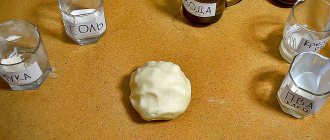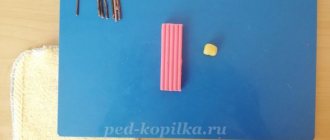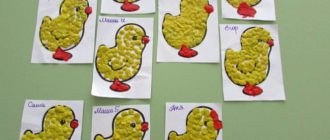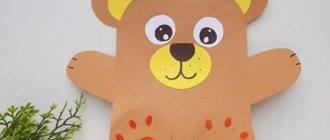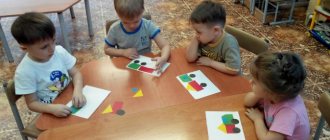Age characteristics of children
A child of preschool and primary school age has different developmental characteristics. The variety of application techniques allows you to implement them, regardless of category. For example, putting together a composition from ready-made elements will interest children; the appliqué “Birds of Migratory” in the senior group of a preschool institution is more complex in nature (children are asked to independently cut out parts of the composition and put them together in the required sequence); a child 5-8 years old can independently design a craft.
In this work, you can use many techniques that will allow you to fully unleash your child’s creative potential. In this case, not only elements made of paper and cardboard are used, but also various natural materials, such as feathers or down.
Lesson summary on appliqué in the middle group “Birds”
Lesson summary on appliqué in the middle group “Birds”
Target:
teach children to make an applique in the shape of a bird.
Tasks:
educational: to consolidate children’s understanding of the diversity of birds, their structural features, and distinctive features; strengthen the ability to carefully use glue;
developmental: develop fine motor skills of fingers; develop attention, observation, perseverance;
educational: to cultivate friendly attitudes towards nature and its inhabitants.
Material and equipment:
Audio recording “Bird Voices”
, templates made of colored paper: circles 5 cm and 3 cm, 3 semicircles, a colored sheet of cardboard, felt-tip pens, glue, napkin.
Preliminary work:
Reading the fairy tale “Wonderful Houses or a Tale of Winter and Birds”; looking at illustrations of birds.
Progress of the lesson:
-Guys, today we will go on a trip to a forest clearing. We'll go by bus. So, sit down and let's leave together. (Children enter a group that is decorated with images of birds and sit on chairs.)
-Listen, guys, who sings so beautifully? (Children's answers.)
-Where did they hide? Let's find them and see who flew to us today. This is a magpie. Her sides are white. This is a sparrow. A fast jumper.
-What kind of bird is this in a red cap, knocking on a tree with its sharp beak? (Children's answers.)
-And this is a tit, she has a yellow belly. All these birds live next to us both in winter and summer.
- But this bird flew to us from the south. This is a swallow. It flies quickly, catches mosquitoes and other harmful insects.
-Look, guys, what is this unusual bird? I think I know: this bird was made by children from another kindergarten and sent to see the world. Is it really beautiful?
-Yes!
- Do you want me to teach you how to make the same beautiful birds? Just first let’s say what parts our bird consists of. I will show, and you name these parts. (Children's answers.)
Physical school:
Birds are jumping, flying (Children are jumping) Birds are collecting crumbs. (“Peck”) Feathers have been cleaned, Beaks have been cleaned (depict) Birds are flying, singing (waving their arms) Grains are pecking (leaning down) Then they flew and sat down (fly away, sit down) tables)
-Look at what lies in front of you: circles for the body and head, semicircles for the wings and tail.
-Let's stretch our fingers.
Finger gymnastics “Bird feeder”:
We hung feeders,
(Children imitate movements)
Grain was poured into them.
(Imitate movements)
For hungry birds in winter
It's very tasty.
Come to us, tits,
(They bend their fingers one by one, listing the birds)
Pigeon, crossbill and sparrow!
And, of course, we are waiting for your visit
Interesting ideas and application patterns on the topic “Birds” in the preparatory group
Children are very fond of fantasy works, for example, interpretations on the theme “Fairytale Bird” (photo 4, 8, 14, 18). They like to choose colors and shapes of feathers according to their wishes. In this regard, the work “Firebird” (photo 8) is interesting, where the feather on the tail is represented in the form of a cascade of droplets. The “Bird of Happiness” applique looks unusually effective (photo 18): the bird is all shiny and shimmers due to the bright candy wrappers from the endowment, the decor made of lace fabric looks elegant. Photo 14 - collective work, each child painted a feather to his or her taste, and together they made the tail of a magical bird. Fantasy works also include the composition “Festive outfit for an owl” (photo 17).
Three-dimensional compositions, which we see in photos 1, 5, 6, 7, 13, 15, 20, always look beautiful. A similar effect is achieved by partially gluing the silhouette of a bird, as well as using the technique of applique from strips, applique from lumps of napkins or pieces of torn colored paper.
A charming craft is a cockerel made from dry leaves (photo 2); this application is usually done in the fall. Another rooster is also made of non-traditional material - fabric (photo 16), the variety of patch patterns gives it a bright look.
Children will probably be happy to start making crafts “Sovunya” - a character from the cartoon “Smeshariki”; it is made of simple parts, but looks quite original.
Preschoolers also love group creativity. In this regard, the works in photos 1, 10, 11, 12, 13, 14, 19 are interesting (the children created the composition as a whole group or worked in a subgroup). Such activities, without a doubt, unite the guys, force them to be more attentive to each other, and jointly enjoy the results of their work. The basis of such compositions is usually prepared in advance by the teacher. This could be a tree with many branches on which the birds will be located, or a painted feeder where the birds will happily dine. Oh, where water is depicted in an unusual way - using blue and red strips of paper that convey reflections.
Photo: domestic and wild birds - rooster, cranes, firebird, swan, owl, duckling, etc.
Work in a subgroup
Application from dry leaves Application
Application
Application from strips of paper
Volume applique
Application
Application
Subject composition
Teamwork
Teamwork
Teamwork
Teamwork
Teamwork
Teamwork
Fabric applique Applique Applique using candy wrappers and lace
Work in a subgroup
Volume applique
Subject application
Templates
Part templates
Part templates
Silhouette cutting template
Part templates
Part templates
Aspects of conducting appliqué classes in the preparatory group of a preschool educational institution
Children's independence in making initial parts and working with materials
Preschoolers aged 6–7 years are already quite good at using scissors and glue, and appliqué in the preparatory group is already much more difficult than classes at an earlier age. Artistic images have a great resemblance to real objects: children not only know and imagine what a variety of birds look like, but are also able to recreate them on paper.
In this group, during appliqué classes, plot compositions already take place, which provide for a certain sequence in the arrangement and gluing of parts to the base. First the background of the application, the background, and then the foreground are drawn up. The guys already understand that objects can overlap one another.
Pupils are already harmoniously placing figures on paper, selecting the proportions of objects according to the format of the base. Children are able to create compositions not only on the usual A4 sheet of paper, but also on other forms (a strip of paper, round and square bases).
In the preparatory group, children improve the basic types of cutting: cutting paper strictly along the fold line, as well as visually, rounding the corners of a square or rectangle, achieving round and oval shapes, cutting out symmetrical shapes from a sheet of paper folded in half. In addition, students can already cut out many identical elements from material folded several times. Such a complex technique as silhouette cutting (along a linear contour) is being taught, while the child must keep in memory a complete image of the object and ensure that its proportions are correct.
As for the immediate preparation for the lesson, the teacher can offer the parts he has cut, but preschoolers of this age are quite capable of cutting them out of paper, fabric and other materials on their own. In addition, preschoolers aged 6–7 years old have access to the tearing technique - they are able to tear pieces of colored paper or napkins themselves, from which they will later make a composition. If dry leaves are used as the main material for the applique (as a rule, these are autumn compositions), then the children will be happy to collect them during a walk.
As for the size of the original parts, they must correspond to the format of the base. The elements should not be too small (exceptions are the eyes and beak of the bird).
The most suitable materials, including for the base
Since in the preparatory group much attention is paid to applique by design (a striking example of this is the theme “Fairytale Bird”), the teacher provides children with a wide selection of paper of various colors and shades (matte and glossy) - this promotes independence and creativity. If the required shades are not available, the paper can be pre-painted. Several guys can do this work on the eve of the application.
Interesting works are obtained by using corrugated or embossed paper. The teacher should not forget that in all cases, be it gluing ready-made forms or cutting them out on their own, the child must have a larger supply of material than is required to complete the work.
As for the background, thicker paper is usually used for it, for example, thin cardboard. Moreover, it does not have to be white.
As for original, unconventional solutions in the choice of material, it could well be dry leaves, dried flowers or fabric. Also, pupils of the preparatory group do an excellent job with straw appliqué: such works look unusually attractive, they shimmer in the sun and fit perfectly into the interior.
Straw applique
As for crafts made from dry leaves, twigs, flowers, such work, in addition to developing creative abilities, promotes rapprochement with nature and fosters a caring attitude toward it. When applying birds, you can also use the most unexpected, at first glance, natural materials: crushed eggshells, small pebbles and shells, poplar fluff.
You can further decorate the composition, especially if it includes fabric elements, with braid, sequins, and confetti. Figures made from torn napkins or cotton wool have a voluminous effect. Applications made from candy wrappers look bright and festive. The choice in this case is limited only by the teacher’s imagination.
For an application on the theme “Birds” in the preparatory group, you can also use plasticine in the form of small balls that create a mosaic pattern. In this case, the outline of the bird is first drawn with a simple pencil on a cardboard base, then covered with transparent tape. Plasticine pieces are attached directly to the tape - in this case, it is easy to correct the mistake, in addition, such a base can be used several times.
A similar technique occurs when creating applicative compositions from pieces of paper. Each piece is rolled into a ball and glued to the base. Such voluminous applications can be supplemented with drawings using paints, pencils or felt-tip pens. Three-dimensional applications that involve origami elements look original.
As for such a tool as scissors, in the preparatory group they should also be small in size, have rounded ends and be easy to move the child’s fingers - the result of the created shape depends on these parameters. To work, children also need special glue brushes and a stand for them (so that the glue does not flow down, dirtying the work area). Each preschooler must also have a tray for scraps, oilcloth and a cloth for fixing glued forms and removing excess glue.
The relevance of collective compositions within the framework of a given topic and the use of an individual approach
In the preparatory group, collective applications are carried out quite often; the theme “Birds” is especially conducive to such work. These could be options such as “Penguins in Antarctica”, “Bird Canteen”, “Bird Yard”, “Flying Migratory Birds”. The teacher prepares a large-format base (a piece of Whatman paper) in advance, colors it in the appropriate background, and the children fill it in with applique details.
In addition, children can be divided into several subgroups and each can be asked to design their own applique plot. Let us note that children aged 6–7 years are already able to independently distribute work among themselves without the help of a teacher, including determining the sequence of gluing.
In the preparatory group, many children already have clearly expressed abilities for visual arts, so an individual approach will be very appropriate. Thus, gifted children can make more than one bird during class (provided they quickly complete the main work) or supplement their composition with additional details.
Leaf craft
Making a firebird from leaves is not at all difficult, just take:
- Dry leaves;
- Glue;
- Paints;
- Glue gun;
- Cardboard for the base.
The first step is to prepare the cardboard for the base. You can paint it the color you want or choose a pre-colored one.
When the paint on the leaves has dried, glue them to the base. Apply a thick layer of hot glue to the cardboard, and also put dots on each leaf so that it sticks well. We lay the leaves on the cardboard as intended and press well. You can use a napkin to remove excess glue.
It's important to remember that hot glue hardens very quickly, so if there are visible marks left, you can paint them with the same paint as the leaves to help the colors blend together.
The next step is to create the body of the bird. For it you will need a dry leaf, different in color from the ones we chose for the tail. We glue it on top of the tail, and also press it tightly with a napkin so that the body sticks well to the leaves.
Cut out the legs and eyes from a dark piece of paper or cardboard and glue them to the body of the firebird.

